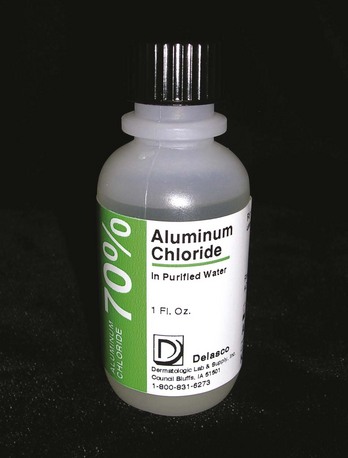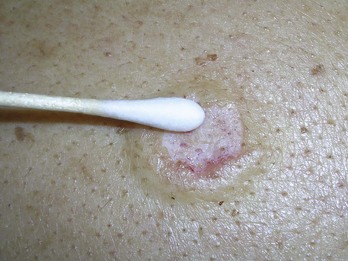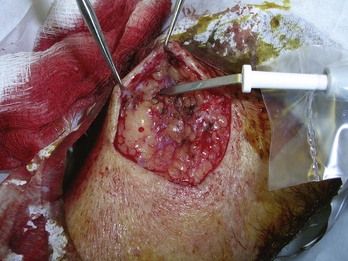4 Hemostasis
Chemical Hemostatic Agents
General Principles of Chemical Hemostasis
All of the hemostatic chemicals can be damaging to the eye. Exercise great caution when using chemical agents after a shave or snip (scissors) biopsy on the eyelids or near the eye. The chemical from a dripping cotton-tipped applicator can run into the eye when the biopsy is close to the globe. The Cryo Tweezer described in Chapter 15 is a preferred method for treating skin tags or warts around the eye to avoid chemical exposures. Using electrosurgery for hemostasis can also keep chemicals away from the eye. If aluminum chloride is to be used in this location, dry off the chemical agent on the cotton-tipped applicator with a gauze pad before carefully touching the cotton-tipped applicator to the eyelid or periocular skin. If any chemical does get into the eye, the eye should be flushed immediately.
Aluminum Chloride
Aluminum chloride comes in strengths from 20% to 70% available in water- or alcohol-based solutions (Figure 4-1). Alcohol alone (anhydrous alcohol) will support a solution of up to 20%, so the stronger concentrations are either in water or a mixture of water and alcohol. I prefer to use aluminum chloride in an aqueous solution because it can be used safely with electrosurgery and comes in higher concentrations. With an alcohol-based solution, it is possible to ignite the alcohol when electrosurgery is performed in the same field. However, drying the field after applying the alcohol-based solution makes it safe to use with electrosurgery.

FIGURE 4-1 70% aluminum chloride in purified water is a useful topical hemostatic agent.
(Copyright Richard P. Usatine, MD.)
Aqueous aluminum chloride can be ordered as a 35% or 70% solution from Delasco (see the Resources section at the end of the chapter for ordering information). Both are inexpensive and excellent for hemostasis. No studies are available to determine whether one percentage is better than another. I use 70% with good results. These solutions have a 3-year shelf life. Drysol, the brand name of 20% aluminum chloride in anhydrous ethyl alcohol that is sold by prescription to treat hyperhidrosis, also produces hemostasis but is more expensive to purchase and messier to use.
The major advantage of aluminum chloride is that it is a clear solution that does not stain or tattoo the tissue. It does not cause tissue necrosis and does not damage the normal skin surrounding the wound. Aluminum chloride should not be used in deep wounds that will be sutured because it can delay healing and increase scarring.1
When using aluminum chloride after a shave or punch biopsy, first dry the field with a cotton-tipped applicator or gauze. The aluminum chloride should then be applied to the dry field by rolling or twisting the moist applicator against the open wound (Figure 4-2). Although light pressure may work, it often helps to use heavier pressure while twisting the applicator clockwise and counterclockwise against the area. After a 2- to 4-mm punch biopsy, a dry cotton-tipped applicator can be held with downward pressure against the open hole to dry the field. If sutures are not to be used, the aluminum chloride should be applied with downward pressure and held against the wound until hemostasis is achieved (Figure 4-3).
Electrocoagulation
Electrocoagulation is an ideal method for controlling bleeding during surgery. This is especially true with an excision that will be closed with sutures. Electrocoagulation is essential in most elliptical excisions and all flaps. During surgery, electrocoagulation helps to produce a relatively bloodless field (Figure 4-4). This helps to see the landmarks for placing both deep and superficial sutures. Electrocoagulation can prevent postoperative bleeding and hematoma formation. Patients should, however, still be given information on what to do if postoperative bleeding occurs and a number to call if help is needed.








